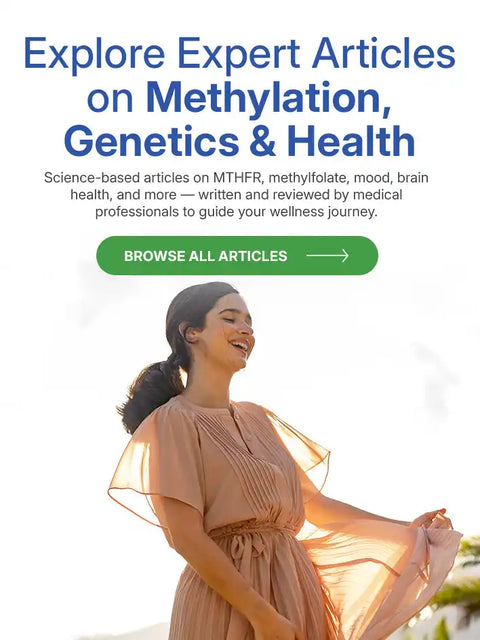
Mental Health/Mood
Discover expert insights and science-backed strategies for supporting mental health, mood balance, and cognitive clarity. Whether you’re seeking natural ways to manage daily stress, improve focus, or boost overall mood, our guides provide practical steps and trusted information.
Explore Now
B12
Our B12 resources explain how active forms like methylcobalamin and hydroxycobalamin support methylation, red blood cell formation, and brain function. Learn why B12 deficiency is common, how it affects fatigue, memory, and mood, and discover which sublingual forms deliver the best absorption.
Explore Now
Cardiovascular Health
Our Cardiovascular Health category highlights how supplements like L-Methylfolate, B12, magnesium, and antioxidants can help maintain healthy homocysteine levels, blood pressure, and vascular function. Learn about the role of methylation in heart health, the importance of nutrient synergy, and lifestyle strategies for long-term cardiovascular wellness.
Explore Now
Children’s Health
Support your child’s growth, development, and long-term wellness with expert resources on children’s nutrition and methylation health. Our Children’s Health category explores how active nutrients like L-Methylfolate, B12, and methylated multivitamins can help maintain healthy development, focus, mood balance, and immune strength.
Explore Now
Energy
Discover how to fuel your body with lasting energy at the cellular level. Our Energy category explores the science of nutrients like L-Methylfolate, B12, magnesium, and mitochondrial antioxidants that help convert food into fuel, support methylation, and maintain stamina throughout the day.

General Health
Explore our General Health blog category, where we cover essential wellness topics ranging from nutritional deficiencies and immune support to restorative sleep and toxin reduction. Learn why vitamins like B12, magnesium, and methylfolate are foundational for long-term wellness and how lifestyle choices impact energy, mood, and disease prevention.

Pregnancy & Fertility
Discover guidance for pregnancy, fertility, and women’s health. Learn how nutrients like L-methylfolate, B12, and prenatal vitamins support conception, fetal development, and maternal wellness. Explore expert articles on fertility challenges, pregnancy nutrition, and postpartum recovery.
Methyl-Life® Blog: Your Trusted Resource for Health, Wellness, and Methylation Support
Welcome to the Methyl-Life® blog, your trusted source for science-backed health education since 2012. Thousands of individuals navigating MTHFR gene mutations, methylation challenges, and nutrient deficiencies have found clarity, support, and actionable solutions here.
Our blog is more than an information hub—it’s a comprehensive resource for reclaiming vitality, boosting energy, enhancing cognitive function, and strengthening immune health.
Unlock the Power of Methylation for Lasting Wellness
Methylation is one of the body’s most essential biochemical processes, influencing:
- DNA repair and cellular renewal
- Detoxification and immune defense
- Neurotransmitter production for mood balance
- Cardiovascular health and homocysteine regulation
Yet, millions struggle with impaired methylation due to genetic variations like MTHFR mutations or nutrient absorption challenges.
At the Methyl-Life® blog, you’ll find easy-to-understand explanations, supplement guides, and practical tips for supporting methylation naturally.
Discover how nutrients such as L-Methylfolate and methylated B12 can optimize your methylation pathways, restore energy, and improve mental clarity.










